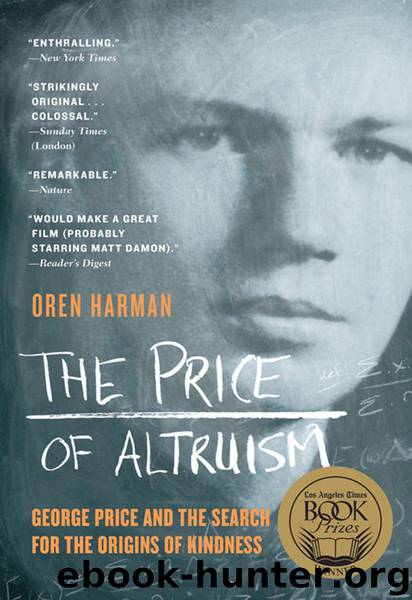The Price of Altruism: George Price and the Search for the Origins of Kindness by Harman Oren

Author:Harman, Oren [Harman, Oren]
Language: eng
Format: mobi
Publisher: W. W. Norton & Company
Published: 2011-06-19T16:00:00+00:00
Excerpts from George Price’s seminal paper in Nature
10
“Coincidence” Conversion
Munich never materialized, but in May a turn arrived as unexpected as it was welcome. “I am enchanted with your formula,” the usually lugubrious Hamilton had written in a hurried script, barely able to contain his excitement. “I really have a clearer picture of the selection process as a result. In its general form I can see how we might use your formula to investigate “‘group selection.’”1
It was quite an about face for a man who had judged group selection as so “wooly” an abstraction that it could be safely omitted from the tool kit of the evolutionist. Altruistic behavior was disadvantageous within groups; to evolve it would require groups fighting among each other. Kin selection, therefore, could not be an alternative to group selection: Both existed in nature’s plan and needed to be related to each other. Accordingly Hamilton had taken George up on spite, and, in the process, devised a foolproof stratagem. It was a piece of trickery that made him especially proud: He would send his article on spite to Nature, wait for its acceptance, and then write to its editor, Maddox, to say that he would have to withdraw since it was entirely based on the covariance math of George Price, whose paper—in case Maddox forgot—had been rejected by him in February. Hamilton would, of course, be happy for “Selfishness and Spiteful Behaviour in an Evolutionary Model” to appear in Nature but not until the status of Dr. Price’s article was finally resolved. A masterstroke of subterfuge, a coup of cunning and guile, amazingly, it worked. George’s letter to the editor, Nature soon replied, would be published as an article, “Selection and Covariance.”2
Walking home that day from UCL, as usual, George eyed the All Souls spire jutting up above the buildings. It was constructed of seventeen concave sides encircled by twelve Corinthian columns, the capitals Ionic in design, made from Coade stone, and the winged heads of the cherubs based on a design by Michelangelo. Three large clocks beneath the columns counted the minutes and hours with black and golden Hermle spade hands. The spire was a perfect cone, as sharp as it seemed foreboding, fearless in the way it pierced the overcast sky. As he turned from narrow Riding House Street into Little Titchfield, George began wondering about his luck, and, in particular, about coincidences.
Later he would write that the “coincidences” that forced him to convert were on the order of 1/1030, odds so fleetingly miniscule that he simply had no choice but to “give in and admit that God existed.”3 “About the beginning of June,” he wrote to his brother, Edison, in the fall, trying to explain,
Download
This site does not store any files on its server. We only index and link to content provided by other sites. Please contact the content providers to delete copyright contents if any and email us, we'll remove relevant links or contents immediately.
Sapiens: A Brief History of Humankind by Yuval Noah Harari(14221)
Sapiens by Yuval Noah Harari(5281)
Pale Blue Dot by Carl Sagan(4886)
Homo Deus: A Brief History of Tomorrow by Yuval Noah Harari(4801)
Livewired by David Eagleman(3663)
Origin Story: A Big History of Everything by David Christian(3632)
Brief Answers to the Big Questions by Stephen Hawking(3358)
Inferior by Angela Saini(3261)
Origin Story by David Christian(3133)
Signature in the Cell: DNA and the Evidence for Intelligent Design by Stephen C. Meyer(3057)
The Gene: An Intimate History by Siddhartha Mukherjee(3030)
The Evolution of Beauty by Richard O. Prum(2926)
Aliens by Jim Al-Khalili(2776)
How The Mind Works by Steven Pinker(2715)
A Short History of Nearly Everything by Bryson Bill(2616)
Sex at Dawn: The Prehistoric Origins of Modern Sexuality by Ryan Christopher(2472)
From Bacteria to Bach and Back by Daniel C. Dennett(2432)
Endless Forms Most Beautiful by Sean B. Carroll(2415)
Who We Are and How We Got Here by David Reich(2387)
